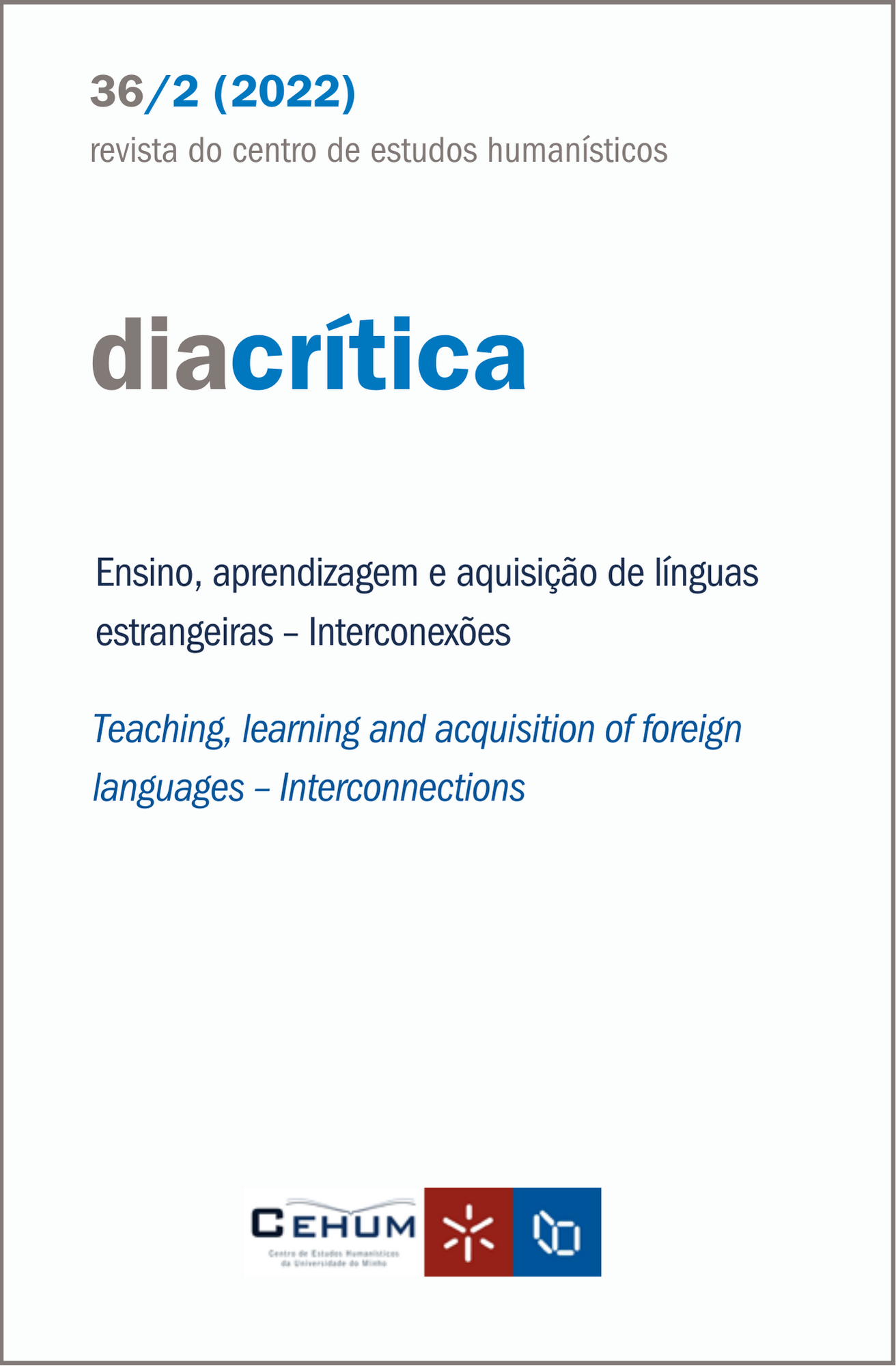A tecnologia capacita: uma investigação do ICALL no desenho de materiais de aprendizagem autorregulada
DOI:
https://doi.org/10.21814/diacritica.4816Palavras-chave:
ICALL, Materiais da aprendizagem autorregulada, PLEResumo
A tecnologia tem gerado convergência no ensino das línguas, melhorando as formas do ensino em aula e criando novas possibilidades de aprendizagem autónoma. Intelligent Computer Assisted Language Learning (ICALL) permite corrigir erros de forma autónoma e inteligente, com base no Sistema Tutorial Inteligente (STI) e desenvolver estratégias de aprendizagem e autonomia. Os materiais de aprendizagem autorregulada associados ao ICALL enriqueceram os métodos de aprendizagem e deram aos aprendentes mais hipóteses de aprendizagem fora das aulas, ajudando-os a desenvolver uma aprendizagem autónoma. Este estudo pretende analisar a influência do ICALL no desenho dos materiais de aprendizagem autorregulada de Português como Língua Estrangeira (PLE), investigando como é que a tecnologia ajuda os aprendentes a entenderem porque é que estudam, o que é que estudam e como é que estudam. Demonstra-se o que é que o ICALL faz melhor na identificação e na correção dos erros, mas também se conclui que ainda é necessário melhorar os seus modelos e estruturas, em comparação com os materiais da aprendizagem autorregulada impressos. Pretende-se assim fomentar a articulação entre a aprendizagem de línguas estrangeiras, entre elas, a aprendizagem de PLE e a dinâmica das sociedades cada vez mais marcadas pelo uso das tecnologias.
Referências
Benson, P. (2001). Teaching and researching autonomy in language learning. Person Education.
Breen, M. P. (1987). Learner contributions to task design. In C.N. Candlin & D. Murphy (Eds.), Language Learning Tasks (pp. 23–46). Prentice-Hall International.
Cai, H. J. (2004). The Theoretical Study on the Development of Self-instructional Materials in Ordinary University [Master dissertation, Fujian Normal University]. CNKI.
Chanier, T. (1994). Special issue on language learning: introduction. Journal of Artificial Intelligence in Education, 5(4), 417–427.
Conselho da Europa. (2001) Quadro Europeu Comum de Referência para as Línguas: aprendizagem, ensino, avaliação. Edições ASA.
Council of Europe. (2020). Common European framework of reference for languages: learning, teaching, assessment – companion volume. Council of Europe Publishing.
Du, L., Lin, Z., & Yin, B. (2010). The application of AI technology in intelligent tutoring system. In 2010 2nd International Conference on Education Technology and Computer (ICETC) (Vol. 1, pp. 490–493). Institute of Electrical and Electronic Engineers DOI: https://doi.org/10.1109/ICETC.2010.5529201
Ellis, R. (2006). The methodology of task-based teaching. Asian EFL Journal, 8(3), 19–45.
Garrett, N. (1995). ICALL and second language acquisition. In V. Melissa Holland, Jonathan D. Kaplan & Michelle R. Sams (Eds.), Intelligent language tutors: theory shaping technology (pp. 363–376). Routledge.
Holec, H. (1981) Autonomy and foreign language learning. Pergamon Press.
Jewitt, C. (2009). An introduction to multimodality. In C. Jewitt (Ed.), The Routledge handbook of multimodal analysis (pp. 14–27). Routledge.
Kessler, G. (2009). Student-initiated attention to form in Wiki-based collaborative writing. Language learning & Tecnology, 13(1), 79–95.
Lennon, P. (1991). Error: some problems of definition, identification, and distinction. Applied Linguistics, 12(2), 180–196. https://doi.org/10.1093/applin/12.2.180 DOI: https://doi.org/10.1093/applin/12.2.180
Levy, M. (1997). Computer assisted language learning: context and conceptualization. Oxford University.
Little, D. (1991). Learner autonomy: definitions, issues and problems. Authentik Language Learning Resources Ltd.
Littlewood, W. (1996). “Autonomy”: an anatomy and a framework. System, 24(4), 427–435. https://doi.org/10.1016/S0346-251X(96)00039-5 DOI: https://doi.org/10.1016/S0346-251X(96)00039-5
Long, M. H. (1985). A role for instruction in second language acquisition: task-based language teaching. In K. Hyltenstam & M. Pienemann (Eds.), Modelling and assessing second language acquisition (Vol. 18, pp. 77–100). Multilingual Matters.
Martin, A., & Ashworth, S. (2004). Welcome to the Journal of eLiteracy!. Journal of eLiteracy, 1(1), 2–6.
Nunan, D. (1997). Designing and adapting materials to encourage learner autonomy. In P. Benson & P. Voller (Eds.), Autonomy and independence in language learning (pp. 192–203). Addison Wesley Longman. DOI: https://doi.org/10.4324/9781315842172-16
Pang, W.G. (2003). Self-regulated learning: principles and educational applications. East China Normal University Press.
Postlethwait, S. N. (1970). The audio-tutorial system. The American Biology Teacher, 32(1), 31–33. https://online.ucpress.edu/abt/article/32/1/31/8390/The-Audio-Tutorial-System DOI: https://doi.org/10.2307/4442884
Ren, D. B. (2009). The essence and features of college self-study teaching material. Economic Research Guide, 25, 258–260.
Rowntree, D. (1990). Teaching through self-instruction: how to develop open learning materials. Kogan Page.
Yu, X. (2021). O desenho dos materiais digitais de aprendizagem autorregulada: no ensino de PLE em nível básico. Portuguese Language Journal, 15, 68–82. https://www.portugueselanguagejournal.com/files/ugd/02e26d_b0677079f4534744b9e4af48edcc1a89.pdf
Yu, X. (2019). Uma investigação para o desenho de materiais de aprendizagem autorregulada de PLE em nível básico no âmbito de ICALL [Dissertação de Mestrado, Universidade de Lisboa]. Repositório da Universidade de Lisboa. https://repositorio.ul.pt/handle/10451/ 40820
Zimmerman, B. (1989). A social cognitive view of self-regulated academic learning, Journal of Educational Psychology, 81(3), 329–339. https://doi.org/10.1037/0022-0663.81.3.329 DOI: https://doi.org/10.1037/0022-0663.81.3.329
Zimmerman, B. J. (1995). Self-efficacy and educational development. In A. Bandura (Ed.), Self-efficacy in changing societies (pp. 202–231). Cambridge University Press. DOI: https://doi.org/10.1017/CBO9780511527692.009
Zimmerman, B.J., & Pons, M. M. (1986). Development of a structured interview of assessing student use of self-regulated learning strategies. American Educational Research Journal, 23(4), 614–628. https://doi.org/10.3102/00028312023004614 DOI: https://doi.org/10.3102/00028312023004614
Downloads
Publicado
Como Citar
Edição
Secção
Licença
Direitos de Autor (c) 2023 Xuechun Yu, Catarina Gaspar

Este trabalho encontra-se publicado com a Creative Commons Atribuição-NãoComercial 4.0.










